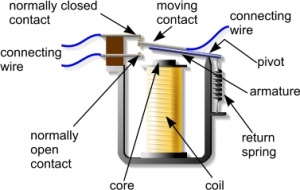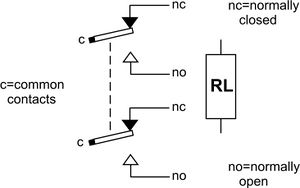Relays: Difference between revisions
From DT Online
m (Added Template) |
(Added Template) |
||
| (4 intermediate revisions by the same user not shown) | |||
| Line 1: | Line 1: | ||
[[File:ElectroMechanicalRelay.jpg|300px|right]] | [[File:ElectroMechanicalRelay.jpg|300px|right]] | ||
__TOC__ | |||
=====Description===== | |||
A [http://en.wikipedia.org/wiki/Relay '''relay'''] is a device which uses a small control current to '''[[Switches|switch]]''' a much larger load current.They are used in switching circuits where the output of that circuit has insufficient power to drive the output device. | A [http://en.wikipedia.org/wiki/Relay '''relay'''] is a device which uses a small control current to '''[[Switches|switch]]''' a much larger load current.They are used in switching circuits where the output of that circuit has insufficient power to drive the output device. | ||
They have disadvantages in that they can only operate at low switching speeds and are relatively expensive. | |||
=====Features and Applications===== | |||
The relay is energised by a control current passing through the magnet's coil attracting the armature and switching the load current. Types of relay coils can be driven by a.c. or d.c. and can vary between a few volts to several hundred. | |||
The relay contacts are known as "normally open" (no),"normally closed" (nc) and "common" (c). They can be used to switch high voltages and currents depending upon the type. When the relay is "off" the common contact touches the normally closed contact. When the coil is energised the common contact switches to the normally open contact. In many relays the contacts are arranged in groups of three. | |||
For example, a DPDT (Double Pole, Double Throw) relay has two sets of contacts which switch at the same time. | |||
[[File:RelaySymbols.jpg|300px|right]] | |||
The symbol for a double pole, single throw '''[[Switches|(DPST)]]''' relay is shown together with a more simple representation of a relay for use in circuit diagrams. | |||
Relays, in common with many other electronic devices which include movement and an electro-magnetic coil, usually have a '''[[Diode|diode]]''' connected in parallel to them to prevent damage caused by [http://en.wikipedia.org/wiki/Counter-electromotive_force '''Back-EMF'''] | |||
| Line 28: | Line 37: | ||
[[File:SolidStateRelay.jpg|100px|right]] | |||
A [http://en.wikipedia.org/wiki/Solid-state_relay '''Solid State Relay ''(SSR)'''''] is a solid state electronic component that provides a similar function to an electromechanical relay but does not have any moving components, increasing long-term reliability. | |||
{{Relays & Solenoids Buyers Guide}} | |||
[[Category:Secondary]] | |||
[[Category:Electronics Components]] | |||
Latest revision as of 15:48, 3 July 2016
Description
A relay is a device which uses a small control current to switch a much larger load current.They are used in switching circuits where the output of that circuit has insufficient power to drive the output device.
They have disadvantages in that they can only operate at low switching speeds and are relatively expensive.
Features and Applications
The relay is energised by a control current passing through the magnet's coil attracting the armature and switching the load current. Types of relay coils can be driven by a.c. or d.c. and can vary between a few volts to several hundred.
The relay contacts are known as "normally open" (no),"normally closed" (nc) and "common" (c). They can be used to switch high voltages and currents depending upon the type. When the relay is "off" the common contact touches the normally closed contact. When the coil is energised the common contact switches to the normally open contact. In many relays the contacts are arranged in groups of three.
For example, a DPDT (Double Pole, Double Throw) relay has two sets of contacts which switch at the same time.
The symbol for a double pole, single throw (DPST) relay is shown together with a more simple representation of a relay for use in circuit diagrams.
Relays, in common with many other electronic devices which include movement and an electro-magnetic coil, usually have a diode connected in parallel to them to prevent damage caused by Back-EMF
A Reed Relay is a reed switch enclosed in a solenoid.
A Solid State Relay (SSR) is a solid state electronic component that provides a similar function to an electromechanical relay but does not have any moving components, increasing long-term reliability.
 |
 |
 |
 |
 |
 |
 |
| General Purpose Relay |
Mini Electronic Power Relay PCB Mount |
SIL Reed Relay |
DIL Reed Relay |
Stroke Push Pull Solenoid |
Solenoid Valve |
Electrical Pneumatic Solenoid Valve |



